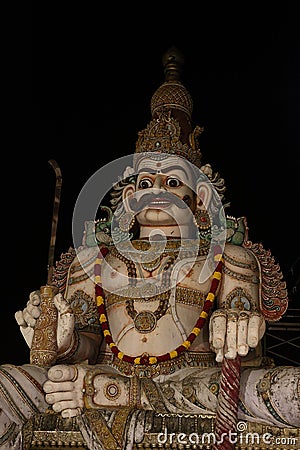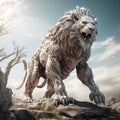Designed by
Title
awe-inspiring, statue of Ayyanar, the revered Dravidian deity. #312126177
Description
Ayyanar, a revered deity in the Dravidian folk religion of South India and Sri Lanka. Ayyanar is primarily worshiped as a guardian deity by the rural Tamil people, and his presence is especially prominent in the villages of Tamil Nadu. The image showcases a magnificent bronze statue of Ayyanar mounted on an elephant, symbolizing his role as the protector of the villages.Ayyanar's depiction in this photo is rich in symbolism and folklore. He is often portrayed riding on either an elephant or a horse, armed with a bow and arrow, ready to defend and save his devotees. Accompanying him are his attendants, Pavadairayan, Karuppasamy, and Madurai Veeran, adding to the grandeur and mystique of the scene.The statues of Ayyanar found in rural areas are known for their colossal size and intricate details. They exhibit a Bhuta-like iconography reminiscent of Sastha, another deity, and are often accompanied by terracotta horses placed outside the temples. These horses are offered to Ayyanar for his nocturnal perambulations, as he roams the village to ensure its protection.Ayyanar's wrathful guardian form shares similarities with Tantric iconography, resembling Bhairava and Vajrayana guardian deities like Acala. In this particular image, Ayyanar is depicted holding a Chentu, a crooked stick, in his right hand. Occasionally, he may be seen carrying a whip, stick, sword, or scepter. His posture is squat, and he wears a Yogapa??am or V?gupa??ai, a meditation band, around his knees and waist.The mount of Ayyanar varies in different depictions. Texts mention a white elephant as his mount, while horses are also commonly associated with him. Some sources refer to a blue horse or bull as alternative mounts. In recent times, the tiger has been identified as a mount due to the influence of the Ayyappan cult.Ayyanar is accompanied by his two wives, Purana and Pushkala, who play significant roles in his worship. Purana, on his right, has a dark complexion and carries Varamudra in her right hand and a blue lotus in her left. Pushkala, on his left, has a yellow complexion and holds a noose in her right hand. In some accounts, Ayyanar is described with only one wife named Prabha, and they have a son named Satyakan, who is depicted as an eight-year-old lad.This captivating stock photo provides a glimpse into the rich mythology, vibrant traditions, and visual splendor associated with the worship of Ayyanar, making it an ideal choice for projects or articles related to South Indian folklore, religious practices, or cultural heritage.
















